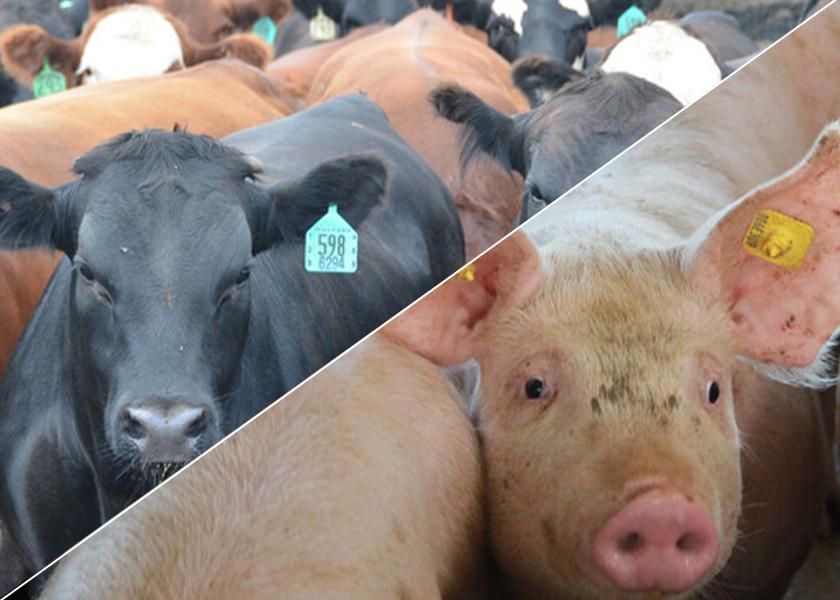Livestock Analysis | February 1, 2022

Price action: April lean hogs rose $1.975 to $97.675 after posting a contract high at $99.15. Deferred contracts also reached contract highs, with June futures touching $108.65.
Fundamental analysis: Hog futures extended a rally that began in mid-January on strengthening cash fundamentals and indications slaughter is returning to normal levels after Covid-related worker absences forced meatpackers to slow processing last month. Strong technicals driving speculative buying, along with a broadly bullish commodity market backdrop, also contributed to hog market strength.
The latest CME lean hog index rose $1.54 to $82.15, the highest reading since Oct. 25, and is expected to jump another 99 cents tomorrow, illustrating cash market strength. Pork cutout values fell 79 cents early today to an average of $93.72, though movement by midday was decent at 169 loads. This week’s hog slaughter through today was an estimated 480,000 head, up 9,000 from the same period last week but down 7,000 from a year ago.
Technical analysis: Market bulls have a solid near-term technical advantage with hog futures in a 2 1/2-month uptrend, though April futures closed today at 71.5 on the Relative Strength Index, indicating possibly overbought conditions. Upside objectives for bulls include closing April futures above solid resistance at $100.00. Downside objectives for bears include closing prices below last week’s low at $93.40 and further support at $91.475.
What to do: Get current with feed advice. We are targeting a drop to the $385 area (50% retracement of the November-to-January rally) to further extend coverage. You remain hand-to-mouth on corn-for-feed needs. Our target for extending corn coverage would be a drop to the $5.75 area.
Hedgers: Carry all risk in the cash market for now.
Feed needs: You have all soymeal needs covered in the cash market through the end of January. You remain hand-to-mouth on corn-for-feed needs.
Price action: April live cattle futures climbed 85 cents to $145.375 after posting a contract high at $145.85. February live cattle rose 72.5 cents to $140.30, the highest close for a nearby contract since March 2016. March feeder futures advanced 67.5 cents to $163.70, the highest close since Jan. 20.
Fundamental analysis: Despite bullish numbers in yesterday’s semi-annual USDA Cattle Inventory Report, live cattle futures didn’t react all that strongly to the news, which isn’t surprising, since the report doesn’t provide much fresh information about the short-to-intermediate term outlook for fed cattle. Longer-term, supplies of calves and yearlings available for feedlots in the months ahead are likely to tighten further and beef supplies likely will tighten as well. USDA’s report showed calf and yearling supplies have fallen sharply and will likely continue doing so this year. The beef cow herd totaled 30.1 million head as of Jan. 1, down 2.0% from a year earlier and the lowest since 2015. All cattle and calves totaled 91.9 million head, also down 2.0% from a year ago.
Indications packers are returning to normal slaughter rates also supported cattle futures. Cattle slaughter so far this week was an estimated 241,000 head, up 8,000 from the same period last week and up 7,000 from the same period in 2021, USDA reported. Slaughter had averaged about 5.0% under year-ago in early-to-mid-January. Bulls were probably encouraged by early indications this week’s cash trade could rise $1.00 to $2.00 from last week. A large early drop in beef cutout values today may have limited gains.
Technical analysis: Bulls still own the short-term technical advantage, as April futures posted a fresh contract high at $146.225 and ended the day at a lifetime-high close of $145.35. However, that was a midrange close and only marginally topped the previous high close from last month. Today’s high now marks initial resistance. The weekly continuation chart suggests additional resistance around $148.35, then at the psychologically important $150.00 level. Look for initial support at today’s low of $144.25, then at the chart gap between $143.225 and $143.275 created by yesterday’s strong opening. Its short-term moving averages imply additional support in the $142.53-$142.08 range. A close below that area would have bears targeting last week’s low at $139.025.
What to do: Get current with feed advice. We are targeting a drop to the $385 area (50% retracement of the November-to-January rally) to further extend coverage. You remain hand-to-mouth on corn-for-feed needs. Our target for extending corn coverage would be a drop to the $5.75 area.
Hedgers: Carry all risk in the cash market for now.
Feed needs: You have all soymeal needs covered in the cash market through the end of January. You remain hand-to-mouth on corn-for-feed needs.






